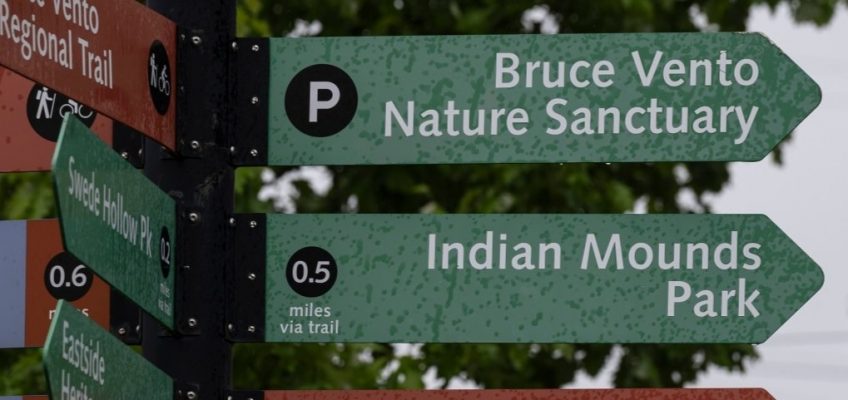A pair of St. Paul parks will be renamed to reflect their sacred significance to the Dakota people.
The City Council on Wednesday voted to change the names of Bruce Vento Nature Sanctuary and Indian Mounds Regional Park to Wakáŋ Tipi and Wic̣aḣapi, respectively. Taken from the Dakota language, Wakáŋ Tipi translates to “dwelling place of the sacred,” while Wic̣aḣapi means “cemetery.”
During a news conference before the vote, Mayor Melvin Carter voiced his support for the new names, which were recommended by Minnesota’s Tribal Historic Preservation Offices and endorsed by the St. Paul Parks and Recreation Commission.
Mayor Melvin Carter talks at a press conference outside his office at City Hall in St. Paul on Wednesday, May 21, 2025. (John Autey / Pioneer Press)
“These names are not just words,” Carter said. “They’re acts of remembrance and resistance, honoring the Dakota people’s enduring presence and spiritual connection to this land. This action today is not about rewriting history, it’s about acknowledging that the land we stand on has always had Dakota names, Dakota meaning and Dakota caretakers.”
Cultural landscape
The two adjoining sites will exist as a newly designated cultural landscape called Imniżaska, which is a Dakota phrase meaning “white cliffs” and has long been used by Dakota speakers to refer to the area that is now St. Paul.
The city’s Parks and Recreation department, which will install updated signage at the sites in coming months, has been working with the Native-led nonprofit Wakáŋ Tipi Awanyankapi for several years to redesign its programming at the two parks to better reflect their spiritual significance in Dakota culture.
Maggie Lorenz, executive director of Wakáŋ Tipi Awanyankapi, said Wednesday that renaming the sites builds on “the work that generations of Dakota people have done … to hold onto our culture, to preserve our history and to advocate for our sacred places.”
Maggie Lorenz, Executive Director of Waḳaƞ Ṭípi Awaƞyaƞkapi, speaks at a news conference outside the mayor’s office at City Hall in St. Paul on Wednesday, May 21, 2025. (John Autey / Pioneer Press)
Last October, the city announced a co-management agreement for the 27-acre Wakáŋ Tipi area with Lorenz’s organization, whose 7,500-square-foot Wakáŋ Tipi Center will house an exhibit hall, classrooms, ceremonial spaces and other facilities dedicated to preserving Dakota culture when it opens in the fall.
Formerly named for the late U.S. Rep. Bruce Vento, an ardent environmentalist who helped spearhead the transformation of what was a polluted former rail yard into green space, the nature sanctuary is home to Wakáŋ Tipi cave, which is revered in Dakota culture as an ancient gathering place for Native American nations.
Vento’s widow, Susan Vento, was consulted as part of the renaming process, according to city officials. Susan Vento did not return a message seeking comment.
Carter said he believes the new name honors Bruce Vento’s legacy, adding that the congressman, who died in 2000, “was a supporter of tribal sovereignty, a supporter of treaty rights, and a champion for our environment.”
The name of the trail system that begins at Wakáŋ Tipi will remain the Bruce Vento Regional Trail.
Lt. Gov. Peggy Flanagan talks at a ness conference, joined by St. Paul mayor Melvin Carter, right, at City Hall in St. Paul on Wednesday, May 21, 2025. (John Autey / Pioneer Press)
Six burial mounds
The former Mounds Park, located on the bluffs overlooking Wakáŋ Tipi, contains six Native American burial mounds — the only such mounds known to exist within the urban Twin Cities.
Estimated to be up to 2,400 years old, the mounds are among the oldest human-made structures in Minnesota and are venerated by Dakota, Ho-Chunk and Ioway people as a burial place of their ancestors.
The city’s parks department in recent years has updated its signage around the mounds to educate visitors on its long history as a cemetery and to encourage them to treat it as such.
Lt. Gov. Peggy Flanagan, who spoke alongside Carter and Lorenz before Wednesday’s council vote, said renaming the sites “acknowledges that Dakota and Native people have always been here, are still here, and will remain here into the future.”
Related Articles
George Floyd: Minneapolis, St. Paul events mark his death, community response
Climate action group schedules first Ward 4 candidate forum for Tuesday
Wet weather continues on Wednesday
St. Paul’s parks rank fifth-best in the nation
Bruce Vento Nature Sanctuary likely to be renamed Wakan Tipi


Leave a Reply